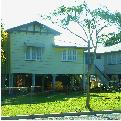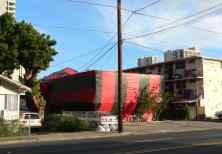Actions to stop or control termites need not be scary.
Termite control comes in four forms: cultural, physical, biological and chemical.
Well, at least those are the headings used in most text books.
Chemical control is the least desirable, but is sometimes the only option.

Cultural control relates to what we do and the way that we do it. It pays to avoid the simple traps that make things inviting for termites. In tropical North Queensland, where life is excellent for pest termites, the old traditional wooden housing style sits up very high. The tall stumps and metal termite caps (inverted pie plates) provide excellent protection against sneaky termites. They can still come in from the ground, but it is far from inviting and they have to build shelter tubes over the pie plates. Not a great option for them and one which makes them very easy to spot. If you follow the “guide to avoiding termite problems” you are instituting a cultural control by reducing the termites’ chances of getting a foothold. Nomadism is another cultural technique–it sort of parallels with disposable coffee cups, only this way it’s your home that is short-lived. Some speculative builders seem to prefer this approach. Beware the short warranty. Keeping a horde of animals to eat swarming termites has to be helpful. Geckoes on the walls will eat many termites. Ants are perhaps the best and most persistent predators, cleaning up the bulk of each alate flight. Even chickens will make short work of termites as they try to extend their shelter tubes.
Physical control separates the food from the termite. Strip shielding, pie plates, posts on stirrups, and physical barrier systems such as Granitgard and exposed slab edges are examples of physical controls. Termites can also be controlled by taking their environment beyond the normal limits that their bodies can take. To this end, both sustained heat (over about 45 degrees C for an hour or so) or sustained cold (subzero–it is the ice-crystals that kill) can been used. Some services also use microwave energy–waves cook things well inside a tightly shielded oven, but it is fairly difficult to control such energy in a structure, where reflection is hard to predict, so be careful out there! These methods are not always a DIY option. Other proposed physical controls include eletrocution (in timber and soil) and bizarre electronic and sound repellents. Be wary of techniques that appear dangerous or hard to believe. If scary sounds did repel termites, they probably wouldn’t ever eat grade schools.
Biological control is practised for many other insect pests, but has had little success with termites. Well, little success in the commercial sense. As with the ants and geckoes mentioned above, many societies have used termites’ natural enemies to keep them in check. Birds and ants can clean up an amazing quantity of termites. Business has tried nematodes and fungi. The nematodes are tiny worms which parasitise termites and the fungi are disease organisms, perhaps best thought of as terminal tinea. While these work extremely well in controlled laboratory experiments, they have yet to make a significant splash in the market. Still, we’re all eagerly waiting and at the moment it looks like nematodes are slightly ahead of the fungi. Flies, beetles and killer viruses also kill termites, so who knows what will happen

Chemical control was once the sum total of pest controllers’ responses to termite problems. Now the consequences of poisoning soils and surfaces are becoming apparent as the old termiticides are withdrawn and the newer ones come under increasing scrutiny. As most commonly practised, chemical control for termites involves either soil treatment to provide a barrier of toxic residues or (for drywoods) tenting of the structure and flooding it with toxic gas (some such fumigants may damage the ozone layer). To be effective, a chemical applied to form a toxic barrier in the soil must penetrate evenly and then bind securely to the soil particles. It has to be persistent. It must not break down through the action of normal soil microbes. Another way to use chemicals is (in much smaller doses) to apply them directly to the termites such as in the bait box technique, either as topical dust, or as bait toxicants. There is a world of difference between surrounding a structure with several kilos of toxin applied in hundreds of litres of emulsion and the at most, few grams of a slow-acting toxin which may be used in a baiting system (the bulk of which may be removed after control is achieved). Other than poisoning the soil and timber, chemicals are also used against drywood termites, but as a whole-structure fumigation or a spot treatment. Spot treatments are only for where you can be 100% sure that you can find and reach each and every drywood colony.
Integrated termite management is a fancy term for putting it all together. For integrated control, you must plan, act as required, monitor, adapt and review. Take the long-term view and you can save a lot of money. Particularly if you build well (with physical barriers) in the first place.
What to do first is usually straightforward. If you have drywood termites, the infestation is usually limited (sometimes to a single piece of furniture, sometimes to the whole house). For subterranean termites, management should first aim to either exclude the termites (such as by repairing a physical barrier) or kill off the offending colony. Colonies can most often be killed by nest destruction, nest poisoning, by baiting or by judicial use of a non-repellent termiticide into the soil where they are active. Repellent soil poisons are best (not used, or) saved for new construction when you can be sure of a complete barrier. In the ideal world, your pest management technician will do a full timber pest inspection of the building and grounds and present you with a written report and (separately) a management plan (hopefully with a range of options). Again, ideally, remedial soil poison barriers would not be used (i) unless necessary and (ii) until the offending colony had been controlled. Repairs (unless for safety) should not be made until the colony is controlled as early disturbance can make management difficult by breaking up or concealing the termite activity. If baiting or using a non-repellent termiticide for colony control, you want to keep them feeding at full tilt until they have consumed enough poison to kill the whole colony.
